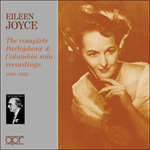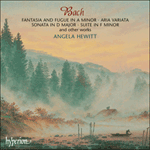The A minor
Fantasia and Fugue, BWV944, is a kettle of fish. Here we really have a case of a free fantasia and a brilliant, virtuoso fugue. It appears in the so-called
Andreas Bach Book – a collection of seventeenth- and eighteenth-century keyboard works by many composers, including J S Bach, put together by Bach’s oldest brother and former keyboard teacher, Johann Christoph Bach. Andreas Bach (1713–1779) was the latter’s youngest son. Many later sources only give the fugue without the fantasia. Mind you, it is hardly a fantasia, simply ten bars of chords marked ‘arpeggio’ with no indication given as to how they should be played. Bach used this notation in the first versions of the Preludes in C major (Book I) and C sharp major (Book II) of
The Well-Tempered Clavier. With both he ultimately did something quite magical. Taking the C sharp major Prelude as my inspiration (but without Bach’s genius, for sure!), I have concocted a figuration that at least stays faithful to the harmonies he outlined. This is, however, only a brief warming-up for what is to come: the whirlwind, moto perpetuo fugue gives us no time to dally. It is long so it needs to move if we aren’t to lose interest. Two pedal points help to build up the excitement, along with stabbing crotchets. The end comes so suddenly that we are almost taken aback; but that must have been what Bach wanted as the last chord is written as a crotchet followed by rests. No long drawn-out ending here.
from notes by Angela Hewitt © 2004
En la mineur, la
Fantaisie et Fugue, BWV944 est vraiment l’exemple d’une fantaisie libre et d’une fugue virtuose, brillante. Elle figure dans ce qu’on appelle le
Recueil Andreas Bach – des œuvres pour le clavier des XVIIe et XVIIIe siècles écrites par de nombreux compositeurs, notamment Jean-Sébastien Bach, réunies par le fils aîné de Bach et son ancien professeur de clavier, Johann Christoph Bach. Andreas Bach (1713–1779) est le plus jeune fils de ce dernier. Dans la plupart des sources ultérieures, la fugue apparaît sans la fantaisie. Il faut dire que cette fantaisie se limite à dix mesures d’accords notés «arpeggio» sans indication aucune sur la manière dont ils doivent être joués. Bach s’est servi de cette notation dans les premières versions du Prélude en ut majeur (Livre I) et du Prélude en ut dièse majeur (Livre II) du
Clavier bien tempéré. Avec ces deux œuvres, il parvint à réaliser quelque chose de tout à fait magique. Sans prétendre au génie de Bach (ce qui est une certitude!), je me suis inspirée du Prélude en ut dièse. J’ai imaginé une figuration qui suit fidèlement les harmonies que Bach a indiquées. Il s’agit, cependant, d’un simple échauffement pour ce qui va suivre: la fugue en un mouvement perpétuel tourbillonnant qui ne laisse aucun répit. Cette fugue est tellement longue qu’il faut choisir un tempo assez vivant pour ne pas s’en désintéresser. Les deux tenues sur des pédales contribuent à intensifier les sentiments tout comme les noires lancinantes. La conclusion survient de façon tellement abrupte que l’on en serait presque désorienté. Mais c’est certainement ainsi que Bach l’a voulu car le dernier accord est écrit sous la forme d’une noire suivie de silence. Voici un dénouement où il n’est pas question de s’étendre!
extrait des notes rédigées par Angela Hewitt © 2004
Français: Isabelle Battioni
Hier haben wir es mit einer wahrhaftig freien Fantasie und einer brillanten, virtuosen Fuge zu tun. Das Werk ist in dem sogenannten
Andreas Bach Buch aufgezeichnet – eine Sammlung von Klavierwerken des 17. und 18. Jahrhunderts von verschiedenen Komponisten, darunter J.S. Bach, zusammengestellt von Bachs ältestem Bruder und Lehrer, Johann Christoph Bach. Andreas Bach (1713–1779) war der jüngste Sohn Johann Christophs. In zahlreichen späteren Quellen ist nur die Fuge und nicht die Fantasia verzeichnet. Die Fantasia ist jedoch kaum als Fantasia zu bezeichnen: sie besteht aus lediglich zehn Takten mit Akkorden, die mit „Arpeggio“ überschrieben sind, wobei jedoch keinerlei Spielanweisung vorhanden ist. Bach bediente sich derselben Notation in der jeweils ersten Fassung des C-Dur-Präludiums (Teil I) und des Cis-Dur-Präludiums (Teil II) des
Wohltemperierten Klaviers. Beiden Stücken verlieh Bach etwas Zauberhaftes. Ich habe mir das Cis-Dur-Präludium als Vorbild genommen und (natürlich ohne Bachs Genie!) eine Figurierung angefertigt, die wenigstens den von Bach angegebenen Harmonien treu bleibt. Jedoch ist dies nur eine Aufwärmübung für das Folgende: die Fuge im moto perpetuo kommt wie ein Wirbelwind daher und erlaubt keine Trödelei. Sie ist so lang, dass ein rasches Tempo notwendig ist, damit der Hörer das Interesse nicht verliert. Mit Hilfe von zwei Orgelpunkten und stechenden Vierteln wird die Spannung aufgebaut. Das Ende kommt so schnell, dass es uns fast den Atem verschlägt; genau das muss aber Bachs Absicht gewesen sein, da der letzte Akkord als Viertel notiert ist, auf die mehrere Pausen folgen. Es ist dies kein ausgehaltener Schluss!
aus dem Begleittext von Angela Hewitt © 2004
Deutsch: Viola Scheffel


 Bach: Angela Hewitt plays Bach
Bach: Angela Hewitt plays Bach Eileen Joyce - The complete Parlophone & Columbia solo recordings
Eileen Joyce - The complete Parlophone & Columbia solo recordings Bach: Fantasia, Aria & other works
Bach: Fantasia, Aria & other works
